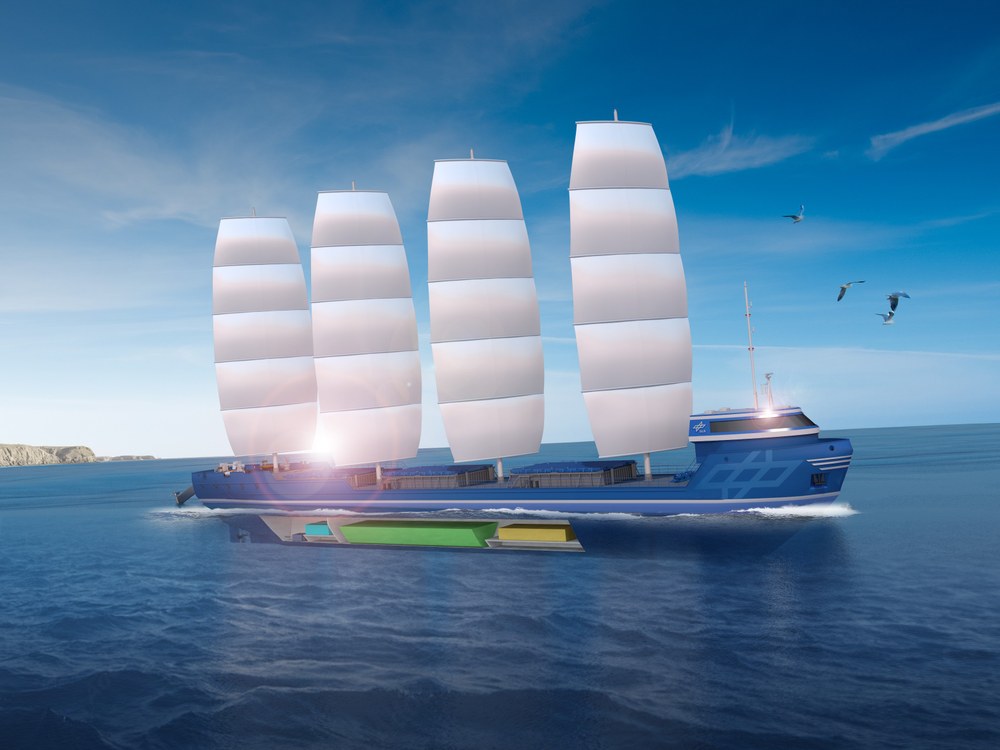Utilisation and Storage of Wind Energy in Maritime Transport
Project duration: May until October 2023
Further research into wind-assisted propulsion and hydrogeneration will be carried out at the DLR Institute of Maritime Energy Systems as a follow-up to the project.
Can goods be transported across the oceans in a climate-neutral way using the power of the wind once again?
As part of the HyRO project funded by the European Regional Development Fund (ERDF), research was carried out into how modern sailing technologies can be utilised as the main propulsion system for ships. The biggest challenge here is to deal with changes in wind speed, wind direction and the associated swell in order to enable the most continuous, energy-saving sailing possible.
The consortium of thyssenkrupp Marine Systems GmbH, the DLR Institute of Maritime Energy Systems and the Helmholtz Centre Hereon pursued the innovative approach of energy recuperation in favourable wind conditions and the use of this energy during low-wind phases. A water turbine on the hull of the ship, also known as a hydrogenerator, generates electricity, which is either used directly on board or converted into hydrogen by means of electrolysis and thus stored. The hydrogen is stored in metal hydride tanks. The hydrogen is chemically bound in metal powders, which greatly reduces the storage volume. Compared to a battery, high-pressure or liquid hydrogen storage system, this system is much more compact, resulting in a larger cargo capacity. The high weight of metal hydride tanks also offers the potential advantage of using the tank as ballast to compensate for the strong lateral forces that typically occur when sailing, particularly in sailing ships. The energy chemically stored in the hydrogen is converted back into electricity via a fuel cell and utilised in an electric propulsion system.
With its expertise in the field of innovative shipping, hydrogen technology and knowledge of the dynamics of the oceans, the consortium researched the potential and limits of this concept in a feasibility study.

Extensive simulation methods have been developed for the aero- and hydrodynamics of the ship, which make it possible to analyse the interaction between the hull, sails, propeller, rudder and appendages for the lateral stabilisation of the ship. This allows the performance of the system to be analysed in a wide range of wind and wave conditions. In combination with temporally and spatially resolved meteorological data from the past decade, ocean crossings of the system can be simulated and the energy balance between sails, propeller drive system and hydrogeneration can be analysed. A model of the energy system on board the ship, consisting of an electric motor, the electrical distribution system, the battery and the hydride storage system, provides information on the efficiency of the recuperation and reconversion of the power-to-gas-to-power system (P2G2P).
Study Results
The study has shown that commercial cargo ships can be equipped with large sail areas to be used as primary propulsion device. By adapting the hull and adding additional appendages, system performance can be boosted considerably. Bulkers and tankers are particularly suitable for these systems due to their open deck areas and slow travelling speeds. With large sail areas, fuel savings of over 50 % can be achieved compared to conventional ships, especially when operating on the windy North Atlantic routes. The sails have a particularly favourable effect when the ship's speed is reduced. At a travelling speed of 7 knots, the system tested achieved savings of up to 67%. Speed optimisation was identified as the key technology for achieving the greatest possible savings. The instantaneous speed of the ship is adapted to the existing wind conditions and recuperation potential so that the average speed remains constant over the entire route. Speed optimisation thus contributes to fuel savings of up to 10 %. It is expected that these results can be further improved through the use of routing. To this end, initial prototypes were developed and tests carried out as part of the study.
During the crossing, the power-to-gas-to-power system enables the absorption of large amounts of recuperation energy, with an improved density compared to battery storage. On the routes analysed, there was an average cycle efficiency of 27% from the recuperator, to hydrogen storage, to reconversion to the drive motor. In windy conditions, the P2G2P can enable completely energy self-sufficient journeys. For the majority of crossings, however, hydrogen must also be refuelled. The conversion of hydrogen into electricity enables emission-free operation. At the same time, the P2G2P system takes up a lot of space and weight, reducing the carrying capacity of the ship by around 37%.
Given the current costs of the technologies used and CO2 pricing, it is not yet possible to achieve economic viability for emission-free cargo sailing compared to conventional cargo ships. However, with increasing regulatory pressure and incentives for sustainable transport, this is certainly conceivable in the future. Further research into wind-assisted propulsion and hydrogeneration will be carried out at the DLR Institute of Maritime Energy Systems as a follow-up to the project.

